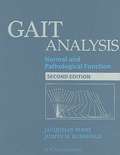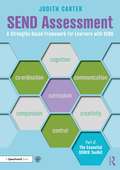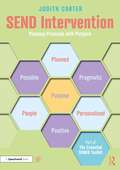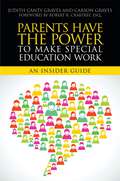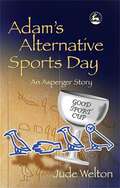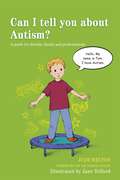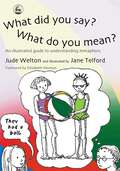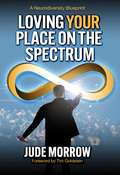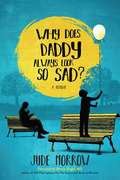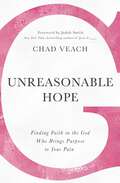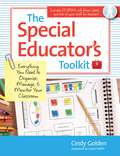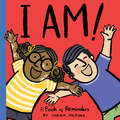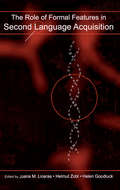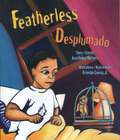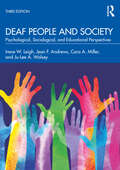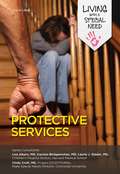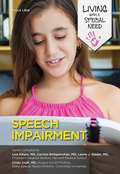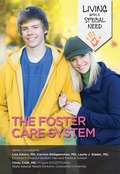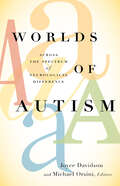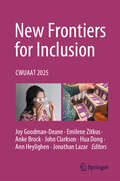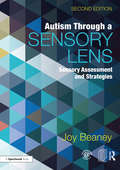- Table View
- List View
Gait Analysis: Normal and Pathological Function
by Jacquelin Perry Judith M. BurnfieldDr. Jacquelin Perry is joined by Dr. Judith Burnfield to present today's latest research findings on human gait. Gait Analysis, Second Edition has been updated and expanded to focus on current research, more sophisticated methods, and the latest equipment available to analyze gait.
SEND Assessment: A Strengths-Based Framework for Learners with SEND (The Essential SENCO Toolkit)
by Judith CarterPart of The Essential SENCO Toolkit series, this invaluable resource offers practical ideas and materials to allow SENCOs and SEN practitioners to capture learning, demonstrate the impact of SEN support, and analyse whether provision is effectively tackling barriers to learning. Chapters introduce a shared language of learning and move through seven key components: cognition, communication, creativity, control, compassion, co-ordination and the curriculum. Key features include: A framework for the holistic assessment of skills and attributes that contribute to accessing the curriculum, and a framework for intervention that is additional to, or different from, the differentiated curriculum A unique strengths-based progress tracker that establishes a baseline to inform intervention and determine progress over time A photocopiable and downloadable programme of materials, trialled and tested in both primary and secondary settings, that can be shared with teachers, senior leaders and support staff, as well as with parents/carers and pupils Providing a framework to create a holistic profile of the child and their needs, SEND Assessment empowers professionals to confidently demonstrate progress for barriers to learning that are otherwise difficult to measure. It will support SENCOs in their day-to-day roles and become a vital tool for those interested in providing effective SEN provision in educational settings.
SEND Intervention: Planning Provision with Purpose (The Essential SENCO Toolkit)
by Judith CarterThe second in The Essential SENCO Toolkit series, this resource clarifies and explores the key distinctions between quality first teaching adjustments, resources/support and interventions. It allows practitioners to develop their practice effectively and strategically to capture the true impact of SEND provision, by shifting the focus from the ‘who and when’ to the ‘what and why’. Chapters also include original frameworks – the 4 Functions of Learning Support – to help with the deployment of teaching assistants and to provide a shared language of support, as well as resources that support the application of the 7 Cs Learning Portfolio (introduced in the first book in the series, SEND Assessment) and an intervention index to fully understand the purpose and effectiveness of interventions. Key features offered: An introduction to the 4 Functions of Learning Support, providing a measurable language of learning support to help practitioners to organise and deploy teaching assistants as part of their SEND provision An intervention index to enable individual or MAT-based SENCOs to capture their own evidence base regarding the purpose and impact of interventions Intervention action cards and targeted outcomes for all 49 themes within the 7 Cs Learning Portfolio A photocopiable and downloadable programme of materials that can be used by readers to gain a better understanding of interventions. SEND Intervention will promote confidence and clarity regarding the rationale for SEND provision. This essential resource provides a practical toolkit to support both new and experienced SENCOs and SEN practitioners.
Parents Have the Power to Make Special Education Work: An Insider Guide
by Carson Graves Judith Canty GravesWritten by parents who have been through the US special education system, this book cuts through the jargon to provide other parents with a no-nonsense road map full of valuable first-hand insights and tried-and-tested advice. The authors clearly describe: · the special education process, including the school hierarchies parents are likely to encounter and etiquette to be aware of when dealing with school personnel · the information parents should expect to see in school evaluations and Individualized Education Programs (IEPs), and what to do when this information is missing or insufficient · problems parents may encounter when the needs of the school conflict with the needs of a child, including how to deal with such situations and when to seek legal advice · the importance of organizing special education documentation and establishing a 'paper trail', and how to begin this process · why transition planning is so important, and transition services parents may want to consider for their child. Demonstrating that parents really do have the power to make special education work for their child, this empowering guide is essential reading for parents of children with disabilities who are new to the special education system in the US, as well as those who feel frustrated with the system.
Adam's Alternative Sports Day: An Asperger Story
by Jude Welton'This is a very useful book for any staff involved in teaching students on the autism spectrum. Its strength is its easy-to-read structure and the engaging illustrations, lists and notes. It meets the needs of many students and adults who find it hard to understand and cope with competition and unstructured events. I can strongly recommend this book to pupils between the ages of 6 and 13 years. It is a good idea for teachers or parents to read it to children and allow them to participate in the activities. It is also a good read for children who do not have Asperger's syndrome as it will help to develop their awareness.' - Good Autism Practice Nine-year-old Adam dreads Sports Day - he usually comes last in the races and never gets chosen for the team events. So he is delighted when Mr Williams, the head teacher, announces that this year there will be an Alternative Sports Day with some very different challenges. There will be quizzes, riddles to solve, and a treasure hunt - all the things that Adam enjoys. At last he'll have a chance of winning something. But as the competition runs high, how will Adam feel if his best friend Josie beats him to the Challenge Cup? And what will they do when they discover that James, the new boy in the class, is cheating? A fun and absorbing children's story, Adam's Alternative Sports Day also offers insights into how a child with Asperger Syndrome copes with the ups and downs and everyday challenges of school.
Can I tell you about Autism?: A guide for friends, family and professionals
by Jude Welton Jane Telford Glenys JonesMeet Tom - a young boy with autism. Tom invites readers to learn about autism from his perspective, helping them to understand what it is and explaining the challenges he faces with issues such as social communication, sensory overload and changes in his routine. Tom tells readers about all the ways he can be helped and supported by those around him. This illustrated book is ideally suited for readers aged 7 and upwards, and will be an excellent way to increase understanding about autism, in the classroom or at home. It also includes clear, useful information for parents and professionals.
What Did You Say? What Do You Mean?: An Illustrated Guide to Understanding Metaphors
by Jude Welton Jane TelfordChildren with autism or Asperger Syndrome (AS) have difficulty understanding figurative language because they use and comprehend language literally and expect words to mean exactly what they say. This can often lead to misunderstandings at home and in the classroom. Jude Welton looks at a hundred of the most common figures of speech in this visual workbook designed as a springboard for family and classroom discussions. Each figure of speech is accompanied by an illustration showing its literal meaning, which will help AS children recognize and learn to enjoy metaphors and figurative language. The book can be used by parents one-to-one with their ASD child. Teachers can also use the book as the basis for classroom work on figurative language.
Loving Your Place on the Spectrum: A Neurodiversity Blueprint
by Jude MorrowLoving Your Place on the Spectrum: A Neurodiversity Blueprint provides answers to many of your questions about autism, helping you to embrace neurodiversity and love your autistic self and the autistic people in your life. Jude Morrow speaks from personal experience when he says that he has learned to be proud to be autistic and he wants you to be proud too.Browse through the many books available on autism and you might notice a trend: too many of them are written by neurotypical professionals who aim to &“fix&” autism or help autistic people appear &“normal.&” Jude Morrow noticed this problem and decided that something needed to change. Loving Your Place on the Spectrum is a guide for living a happy and successful autistic life. Jude combines his own experiences as an autistic man with the stories of others to provide a handbook to help autistic individuals navigate life&’s major changes, from childhood to college, jobs, and relationships. Each chapter identifies common issues faced by autistic people of a particular age or social group and explains how educators, teachers, parents, and professionals can be supportive through all these life stages. The world needs a new perspective on autism, and Jude Morrow&’s Loving Your Place on the Spectrum provides parents, workplaces, individuals, and society an alternative, strengths-based viewpoint, where autistic people are accepted, embraced, and loved.
Why Does Daddy Always Look So Sad?
by Jude MorrowWhy Does Daddy Always Look So Sad? is a poignant and honest memoir detailing Jude Morrow&’s journey to parenthood, and how his autism profoundly affected that journey, for both better and worse, bringing hope to all who live with autism as well as those who care for someone on the spectrum.I knew that Jupiter has seventy-nine known moons and where the swimming pool was located on the Titanic, yet I didn&’t know how to connect with this beautiful child who called me &“Daddy.&” Why Does Daddy Always Look So Sad? is a candid view of life and love through the eyes of an autistic adult—who went from being a nonverbal and aggressive child to a hard working and responsible father to a non-autistic son. Growing up autistic, Jude Morrow faced immense challenges and marginalization, but he was able to successfully—though not without difficulty—finish university and transition into a successful career and eventually parenthood. Those with autism can have difficulty understanding the world around them and can find it hard to find their voice, but in this poignant and honest memoir, Jude defiantly uses his found voice to break down the misconceptions and societal beliefs surrounding autism, bringing hope to all who live with autism as well as those who care for someone on the spectrum. Jude views his autism as a gift to be shared, not a burden to be pitied, and as he demonstrates through his honest recollections and observations, autistic people&’s lives can be every bit as happy and fulfilling as those not on the spectrum.
Unreasonable Hope: Finding Faith in the God Who Brings Purpose to Your Pain
by Judah Smith Chad Veach"Where was God when ____? How could God allow ____? Why?" These are the questions that flood our hearts and minds when the unimaginable happens. When things go horribly wrong and the world seems to be unraveling, how do you believe in God's goodness? How do you cling to hope? Chad Veach directs readers away from clichéd Sunday school answers that fail to offer real comfort or provide faith-building insights. Instead, he draws from God's promises in the Bible and from the story of his own daughter's diagnosis of a devastating and debilitating disease to reveal simple, purposeful steps for dealing with pain. Resting in God's love, remembering his past faithfulness, and realizing the distinction between having faith and clinging to hope are just some of these steps. Veach reminds us that because we know who God is, we know there is hope.
The Special Educator's Toolkit: Everything You Need to Organize, Manage, and Monitor Your Classroom
by Cindy Golden Juane HeflinOverwhelmed special educators: Reduce your stress and support student success with this practical toolkit for whole-classroom organization. A lifesaver for special educators in any Ka 12 setting, this book-and-CD set will help teachers expertly manage everything, from schedules and paperwork to student supports and behavior plans. Cindy Golden, a seasoned special educator, administrator, and psychologist with almost 30 years of experience, has based this teacher-friendly toolkit on her popular OMAC (Organization and Management of All Classrooms) system--an innovative approach to creating effective classrooms for students with all types of disabilities. Special educators will get step-by-step, ready-to-use guidance on managing six key aspects of their daily work: Environment. Make the most of every inch of classroom space Clean out clutter, arrange furniture to improve traffic flow, and construct classroom zones, work stations, and bulletin board displays that support learning. Communication. Implement low-cost communication supports that meet student needs. Make simple picture symbol books, interactive schedules, labels for classroom areas and objects, and more. Teaching Methods and Materials. Determine student needs, create schedules, simplify the IEP process, and pinpoint the best methods for teaching academic, vocational, behavioral, social, and life skills. Behavioral Systems. Organize a successful behavioral system that motivates students, helps them improve behavior and social skills, and uses positive reinforcement techniques. Data and Paperwork. Learn the secrets to creating a simple, logical, highly efficient system for managing paperworka so more time can be spent on teaching. Staff and Home Supports. Build trusting, respectful relationships with classroom staff and parents with stress-free strategies like team meetings and home communication notebooks. For each of these critical areas, special educators will discover dozens of proven strategies, vivid examples, and clever tips and tricks to help them make immediate improvements in their classroom. They'll also get a CD-ROM with more than 60 printable forms and tools they can use right away to support learning, safety, and positive behavior. This is the ultimate guide for every special educator, from the first-year teacher setting up a new classroom to the seasoned veteran who wants a down-to-earth guide to current best practices. Teachers will come away empowered and motivated to get and stay organized--and they'll see the positive results year after year in their classrooms. CD-ROM includes more than 60 printable forms and tools, including Personal Classroom AssessmentClutter Cleaning ChecklistEnvironmental Planning WorksheetCards for Calming DownLunch Visual Schedule PlacematClass Schedule BookletClassroom Expectations ChartFunctional Behavior AssessmentStudent Safety PlanGroup Lesson PlansIndividual Student Lesson PlanIEP and Eligibility CalendarHome and Staff Supports ChecklistHomea School Notesand more "
I Am!: A Book of Reminders (An I WILL! Book)
by Juana MedinaFrom Pura Belpré Award-winning author-illustrator Juana Medina, I AM! helps inspire young readers to have confidence in themselves. This paper-over-board picture book, the second in the I WILL! series, grabs the eye with bold, colorful illustrations and simple text. I am strong.I am confident.I am funny.The words and pictures in this book are here to remind the reader how wonderful they are! Focusing on helping to build emotional literacy, self-esteem, and self-worth as well as improving communication skills, I AM! is the perfect read aloud for kids and adults of any age.
The Role of Formal Features in Second Language Acquisition (Second Language Acquisition Research Series)
by Helen Goodluck Juana M. Liceras Helmut ZoblUsing Chomsky's minimalist program as a framework, this volume explores the role of formal (or functional) features in current descriptions and accounts of language acquistion. In engaging, up-to-date articles, distinguished experts examine the role of features in current versions of generative grammar and in learnibility theory as it relates to native, non-native, and impaired acquisition.
Neurocognitive Rehabilitation of Down Syndrome
by Donna Spiker Jean-Adolphe Rondal Juan PereraDown syndrome is one of the most commonly occurring developmental disorders and it is now possible to conceptualize and define opportunities for neurocognitive rehabilitation for those with the condition. This book describes how early cognitive intervention in children with Down syndrome can be carried out, and can reduce, or compensate for, the major deficits characteristic of the condition. This comprehensive account relates the neurocognitive approach to the major therapeutic endeavors in the neighboring fields of neurogenetics, experimental environmental enrichment, molecular genetics, pharmacology, pediatrics and cardiology for infants with Down syndrome. Neurocognitive Rehabilitation of Down Syndrome provides the guidance required to establish effective rehabilitation programs, and is essential reading for developmental clinicians, pediatricians, neuropsychologists and other health professionals.
Featherless / Desplumado
by Juan Felipe HerreraBilingual English/Spanish. Award-winning children's book author and poet Juan Felipe Herrera offers a story of self-empowerment and friendship.Kids race across the grass,swooping like kites over an emerald sea.No one noticeshow fast I can spin my wheels.Will I ever catch up?Will they ever see me? At his new school or on the soccer field, all everyone wants to know is why Tomasito is in a wheelchair. His Papi gives Tomasisto a new pet to make him smile, but this bird is a little bit different from the rest. Before long, this boy-bird team discovers that there's more than one way to fly-on or off the soccer field-and that those cheers Tomasito hears from the sidelines just might be for him. Goooooooooooal! Award-winning children's book author and poet Juan Felipe Herrera scores yet again with this sparkling story of self-empowerment and friendship. The brilliant acrylic paintings by Ernesto Cuevas, Jr., soar off the page with joy.
Deaf People and Society: Psychological, Sociological, and Educational Perspectives
by Irene W. Leigh Jean F. Andrews Cara A. Miller Ju-Lee A. WolseyDeaf People and Society is an authoritative text that emphasizes the complexities of being D/deaf, DeafBlind, Deaf-Disabled, or hard of hearing, drawing on perspectives from psychology, education, and sociology. This book also explores how the lives of these individuals are impacted by decisions made by professionals in clinics, schools, or other settings. This new edition offers insights on areas critical to Deaf Studies and Disability Studies, with particular emphasis on multiculturalism, equity, and inclusion. Accessibly written, the chapters include objectives and suggested further reading that provides valuable leads and context. Additionally, these chapters have been thoroughly revised and incorporate a range of relevant topics including etiologies of deafness; cognition and communication; bilingual, bimodal, and monolingual approaches to language learning; childhood psychological issues; psychological and sociological viewpoints of deaf adults; the criminal justice system and deaf people; psychodynamics of interaction between deaf and hearing people; and future trends. The book also includes case studies covering hearing children of deaf adults, a young deaf adult with mental illness, and more. Written by a seasoned D/deaf/hard of hearing and hearing bilingual team, this unique text continues to be the go-to resource for students and future professionals interested in working with D/deaf, DeafBlind, and hard-of-hearing persons. Its contents will resonate with anyone interested in serving and enhancing their knowledge of their lived experiences of D/deaf, DeafBlind, Deaf-Disabled, and hard-of-hearing people and communities.
Deaf People and Society: Psychological, Sociological, and Educational Perspectives
by Irene W. Leigh Jean F. Andrews Cara A. Miller Ju-Lee A. WolseyDeaf People and Society is an authoritative text that emphasizes the complexities of being D/deaf, DeafBlind, Deaf-Disabled, or hard of hearing, drawing on perspectives from psychology, education, and sociology. This book also explores how the lives of these individuals are impacted by decisions made by professionals in clinics, schools, or other settings. This new edition offers insights on areas critical to Deaf Studies and Disability Studies, with particular emphasis on multiculturalism and multilingualism, as well as diversity, equity, and inclusion. Accessibly written, the chapters include objectives and suggested further reading that provides valuable leads and context. Additionally, these chapters have been thoroughly revised and incorporate a range of relevant topics including etiologies of deafness; cognition and communication; bilingual, bimodal, and monolingual approaches to language learning; childhood psychological issues; psychological and sociological viewpoints of deaf adults; the criminal justice system and deaf people; psychodynamics of interaction between deaf and hearing people; and future trends. The book also includes case studies covering hearing children of deaf adults, a young deaf adult with mental illness, and more.Written by a seasoned D/deaf/hard of hearing and hearing bilingual team, this unique text continues to be the go-to resource for students and future professionals interested in working with D/deaf, DeafBlind, and hard-of-hearing persons. Its contents will resonate with anyone interested in serving and enhancing their knowledge of their lived experiences of D/deaf, DeafBlind, Deaf-Disabled, and hard-of-hearing people and communities.
Protective Services
by Joyce LibalNot every child is lucky enough to live in a safe, loving home. Many young people live in difficult, unhealthy, or even dangerous conditions. Luckily, there are systems in place to help kids caught in theses situations. Child protective services are working hard to help children in need. Ryan Delaney is one of these kids. He spends most of his time living in a fantasy world, because that's easier than facing his real life. He lies to his friends about his parents and his home--but eventually, the truth catches up with him, forcing him to get the help he needs. As you read Ryan's story, you will learn about the history of the child protective services and find out about the programs and services offered today.
Speech Impairment
by Joyce LibalWhen a young person can't speak easily, sometimes other kids think he's not very intelligent. That's often not the case, though. A person with a speech impairment may be just as bright as anyone else. In this book, you'll read about David, who struggles with stuttering, and Martha, who has difficulty articulating certain sounds. You'll discover how they overcome their challenges--and how they rise above the prejudice they each face.
The Foster Care System
by Joyce LibalIf your parents were unable to care for you, where would you go? Do you have family or friends who would take you in and support you? Unfortunately, many children don't have this option. The foster care system was put in place to help young people who find themselves without homes. As you follow the story of Bobby and Cara, two children whose family was torn apart, you'll discover more about the foster care system. You'll learn about the history behind the system, from the Orphan Trains in the United States to the British Home Children who were originally sent to Canada--and you'll discover some of the challenges young people in the foster care system face today.
Yellow Bird and Me
by Joyce HansenDoris becomes friends with Yellow Bird as she helps him with his studies and his part in the school play and discovers that he has a problem known as dyslexia. Sequel to The gift-giver.
Worlds of Autism: Across the Spectrum of Neurological Difference
by Joyce Davidson and Michael OrsiniSince first being identified as a distinct psychiatric disorder in 1943, autism has been steeped in contestation and controversy. Present-day skirmishes over the potential causes of autism, how or even if it should be treated, and the place of Asperger&’s syndrome on the autism spectrum are the subjects of intense debate in the research community, in the media, and among those with autism and their families. Bringing together innovative work on autism by international scholars in the social sciences and humanities, Worlds of Autism boldly challenges the deficit narrative prevalent in both popular and scientific accounts of autism spectrum disorders, instead situating autism within an abilities framework that respects the complex personhood of individuals with autism. A major contribution to the emerging, interdisciplinary field of critical autism studies, this book is methodologically and conceptually broad. Its authors explore the philosophical questions raised by autism, such as how it complicates neurotypical understandings of personhood; grapple with the politics that inform autism research, treatment, and care; investigate the diagnosis of autism and the recognition of difference; and assess representations of autism and stories told by and about those with autism.From empathy, social circles, and Internet communities to biopolitics, genetics, and diagnoses, Worlds of Autism features a range of perspectives on autistic subjectivities and the politics of cognitive difference, confronting society&’s assumptions about those with autism and the characterization of autism as a disability. Contributors: Dana Lee Baker, Washington State U; Beatrice Bonniau, Paris Descartes U; Charlotte Brownlow, U of Southern Queensland, Australia; Kristin Bumiller, Amherst College; Brigitte Chamak, Paris Descartes U; Kristina Chew, Saint Peter&’s U, New Jersey; Patrick McDonagh, Concordia U, Montreal; Stuart Murray, U of Leeds; Majia Holmer Nadesan, Arizona State U; Christina Nicolaidis, Portland State U; Lindsay O'Dell, Open U, London; Francisco Ortega, State U of Rio de Janeiro; Mark Osteen, Loyola U, Maryland; Dawn Eddings Prince; Dora Raymaker; Sara Ryan, U of Oxford; Lila Walsh.
Go-To-Guide for Social Skills
by Joyce A. OlsonThis go-to guide is a valuable tool for teachers and parents of children with challenging behaviors. It details step-by-step instructions for writing a solid IEP (Individual Education Plan), a FBA (Functional Behavior Assessment) and a BIP (Behavior Intervention Plan). It also gives suggestions for alternative behaviors and how to incorporate those behaviors into the child's behavior routine. There is a very simple but effective Anger Management program for children of school age.
New Frontiers for Inclusion: CWUAAT 2025
by John Clarkson Jonathan Lazar Ann Heylighen Hua Dong Joy Goodman-Deane Emilene Zitkus Anke BrockThis book presents papers from the 12th Cambridge Workshop on Universal Access and Assistive Technology (CWUAAT 2025), to be held in April 2025. This workshop series has hosted the multifaceted dialogue on design for inclusion since 2002, involving disciplines including design, computer science, engineering, architecture, ergonomics and human factors, policy and gerontology. The conference theme for 2025 is New frontiers for inclusion. The major themes dealt with in this collection include: Understanding people Designing for an ageing population Designing for particular needs Designing inclusive environments New challenges and opportunities the possibilities and challenges for inclusive design offered by AI and other emerging technologies. With its thematic wealth, this proceedings provides a unique insight into the current national and international research in the fields of inclusive design, universal access, and assistive and rehabilitative technology.
Autism Through A Sensory Lens: Sensory Assessment and Strategies
by Joy BeaneyThe fully revised second edition of this easy-to-use resource introduces the sensory differences autistic children may face, and explores how these differences can affect their ability to make sense of the world. It is invaluable in helping those adults working with autistic children to identify the possible triggers for the child’s behaviour and consider it through a sensory lens. Children have varying sensory needs so the book offers both a wealth of enjoyable activities for sensory exploration and play, whilst also providing suggestions for strategies and ideas that can be used at home or in school to create an autism-friendly environment. This book: Highlights the possible link between behaviours that challenge and sensory difficulties for autistic children. Provides practical and accessible resources, helping parents, carers and practitioners to gain a greater understanding of sensory differences. Includes an online assessment with accompanying aids to create a visual representation of the child’s sensory needs. With both downloadable and photocopiable resources, this practical guide will be an essential tool for parents, carers and practitioners working with children with autism, enabling them to to create a visual profile of areas of difficulty which can form the basis of personalised strategies and fun sensory activities to support the child.
